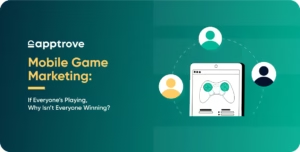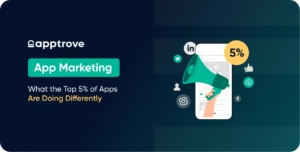App Store Optimization strategies are essential in today’s crowded marketplace, where over 2.6 million Android apps sit in Google Play and more than 2 million iOS apps compete in Apple’s App Store. With such massive numbers, app store search engine optimization has become extremely important for visibility and growth.
These are huge and mind-boggling statistics, especially if you’re a developer trying to get your software recognized.
How can you distinguish yourself in a crowded field of competitors? And, how do you beat such tremendous competition, and get your software to rank high in an App Store search while still ensuring that it meets the intent of App Store searches? The goal is to employ effective App Store Optimization methods for both the Google Play and iOS App Stores, this is where platforms like Apptrove can help simplify and strengthen your approach.
What exactly is App Store Optimization?
In simple words, App Store Optimization is sometimes referred to as Search Engine Optimization for applications (App SEO). App developers must use App Store Optimization strategies to bring their app to the top of app store search results, similar to the way the internet marketers use Search Engine Optimization to get their web sites rank higher in Google’s search results. It may also be thought of as App Store SEO.
The goal of these strategies is to make your app easier to find, more appealing to download, and ultimately more successful in driving user growth.
Unfortunately, the exact algorithms for ranking in both Apple’s App Store and Google Play for Android applications, as well as the genuine algorithms for SEO, are not known and change on a frequent basis. However, we do know that certain factors have a greater impact on your App Store rankings than others:
1. Use Keywords That Are Relevant
It is extremely crucial to conduct keyword research for your target audience.
You’ll need to figure out what keywords your potential consumers are looking for, as well as which keywords your top rivals are using.
Matching keywords to your consumers’ demands will make it easier for them to locate your app in the app store.
- If you choose terms that are irrelevant to your app, your rating will suffer.
- Use only one version of a term (singular or plural).
- Do not use keywords that involve the term “app” or the brand names of your rivals.
We recommend starting with Google Keyword Planner and progressing to app store optimization tools like Mobile Action and Sensor Tower.
2. Investigate Your Competition
Understanding your rivals and their business strategies is critical for any successful organization, but it is extremely critical in ASO.
Before submitting your app to the marketplace, you need to determine the appropriate category for it.
Consider the following factors while selecting a category:
- the number of competitors
- the number of apps that are regularly updated
- how well-known the category is (in downloads)
After you’ve submitted your app to the app store, you’ll need to keep an eye on the top-performing applications in your selected category. When they add a keyword or alter their information, see whether their ranking changes.
Make every effort to rank new keywords before your rivals do. You should also keep an eye on rivals who have a similar goal, app features, or even applications that use the same top keywords as you.
You should be able to narrow down your top rivals to five, according to App Tweak, a competition analysis tool, so you can maintain a consistent ASO practice.
3. Make Sure Your Title and Description are Optimized.
The single most essential information you can utilize to increase downloads is titles.
Concentrate on crafting a title that is less than 25 characters long so that the whole title may be shown on the app’s explore the screen. To promote downloads, a title should be memorable. Your app will be simpler to find if you use your company’s name and top keyword.
Try searching for your app after you’ve decided on a title. Your title isn’t innovative enough if there are thousands of results.
In the first 250 characters of the description, incorporate as many relevant keywords as possible (without cramming). Anything beyond this first explanation necessitates a potential customer’s click to “learn more.”
4. Use Eye-Catching Icons, Screenshots, and Videos in Your Presentation.
Visually appealing apps may help you stand out in the app store.
Select an app icon that is easily recognizable and memorable for your company. To avoid any customer misunderstanding, try to utilize different colors than your main rivals.
Don’t scrimp on your screenshots because the bulk of users will glance at them before deciding whether or not to download your app. We urge that you post as many screenshots as the marketplace allows.
Including a video on your app’s landing page may boost downloads by 35%.
This large improvement is due to more than just title (15 percent) and graphic optimization (30 percent). Every increase in downloads boosts your search engine results.
Upload a video that highlights your app’s most valuable feature, as most users like to search for and download apps in a matter of minutes.
5. Create Backlinks
Your app should be actively connected to websites that are related to your app and have authority according to Google’s current algorithm requirements to create the best backlinks.
Backlinks can be text or image-based, with the ALT (ALTernative text) tag.
While there is some debate over the usefulness of backlinks in terms of ASO, it is clear that quality over number is the best way to achieve backlink success.
The Future of App Store Optimization Strategies
ASO is evolving with shifts in privacy policies, algorithm updates, and user expectations. The future lies in personalization, creative storytelling, and advanced analytics to refine App Store Optimization strategies further.
To stay competitive, you’ll need to experiment, adapt, and continuously invest in ASO, not just as a one-time tactic but as an ongoing growth strategy.
Concluding Remarks
This article is intended to help you go further into the many components of ASO so that you may get the most out of your ASO efforts. It’s worth bookmarking and returning to when you need data-driven insights on a certain ASO topic.
As an ASO specialist, you should always keep on top of these changes because the App Store and Google Play are always changing with upgrades and new features. We’ll keep this guide up to current so you can rely on it to help you enhance every aspect of your ASO.
We hope you enjoyed it and found it useful as you try to improve your ASO knowledge.
Frequently Asked Questions
1. What is App Store Optimization (ASO)?
App Store Optimization (ASO) is the process of improving an app’s visibility in app stores like Apple App Store and Google Play. It involves optimizing keywords, descriptions, visuals, and reviews to boost rankings and installs.
2. Why is App Store Optimization important?
ASO helps apps rank higher in search results, which increases visibility and installs. With millions of apps competing for attention, effective ASO ensures your app gets discovered by the right users.
3. How does App Store Optimization increase installs?
ASO improves an app’s ranking for relevant keywords, making it easier for users to find it. Better visuals, reviews, and descriptions also drive higher conversion rates, resulting in more installs.
4. What are the key elements of App Store Optimization?
The main elements of ASO include keyword research, app title and description, visuals (icon, screenshots, videos), app ratings and reviews, and regular updates.
5. Is App Store Optimization different for iOS and Android apps?
Yes. While the principles are similar, Apple’s App Store and Google Play have different ranking factors. For example, Apple emphasizes keywords in the title, while Google Play also indexes descriptions.






